Abstract
The growth and endocrine sequelae of 75 children (33 girls and 42 boys) with craniopharyngioma, treated from 1973 to 1994, were studied by retrospective review and by follow up assessment in 66 survivors, with a mean time from initial surgery of 6.7 years (range 1.5 to 19.8 years). Although infrequently complained of, 71% of patients had symptoms to suggest an endocrinopathy at diagnosis. After surgery, multiple endocrinopathies were almost universal, such that 75% of children had panhypopituitarism at follow up. Hypoadrenal crises in association with intercurrent illness contributed significantly to morbidity and mortality, as did the metabolic consequences of concomitant antidiuretic hormone (ADH) insufficiency and absent thirst. Final height in 25 patients was significantly below genetic target height, particularly in the girls, with loss of height potential occurring during the pubertal years. The endocrine morbidity associated with craniopharyngioma and its treatment remains high but manageable with appropriate hormone replacement. However, the combination of ADH insufficiency and an impaired sense of thirst following aggressive surgery and severe hypothalamic injury remains one of the most complex management problems.
Full text
PDF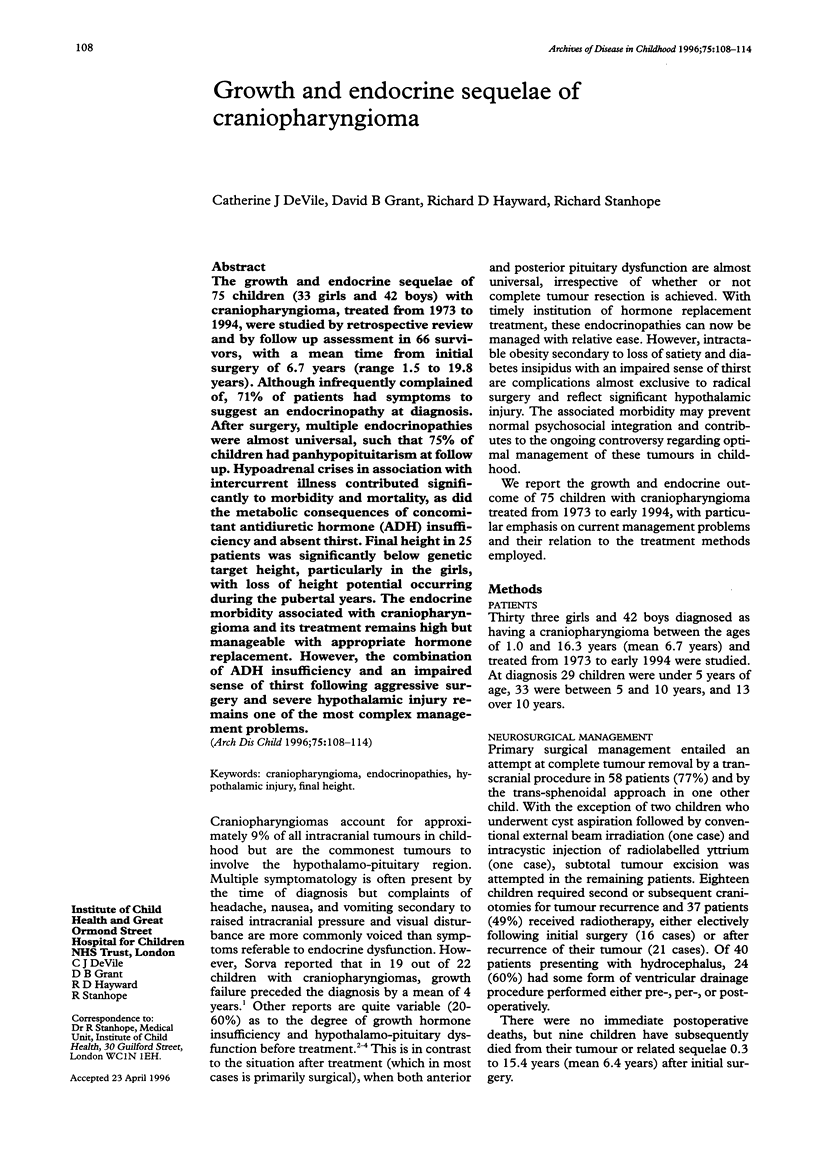
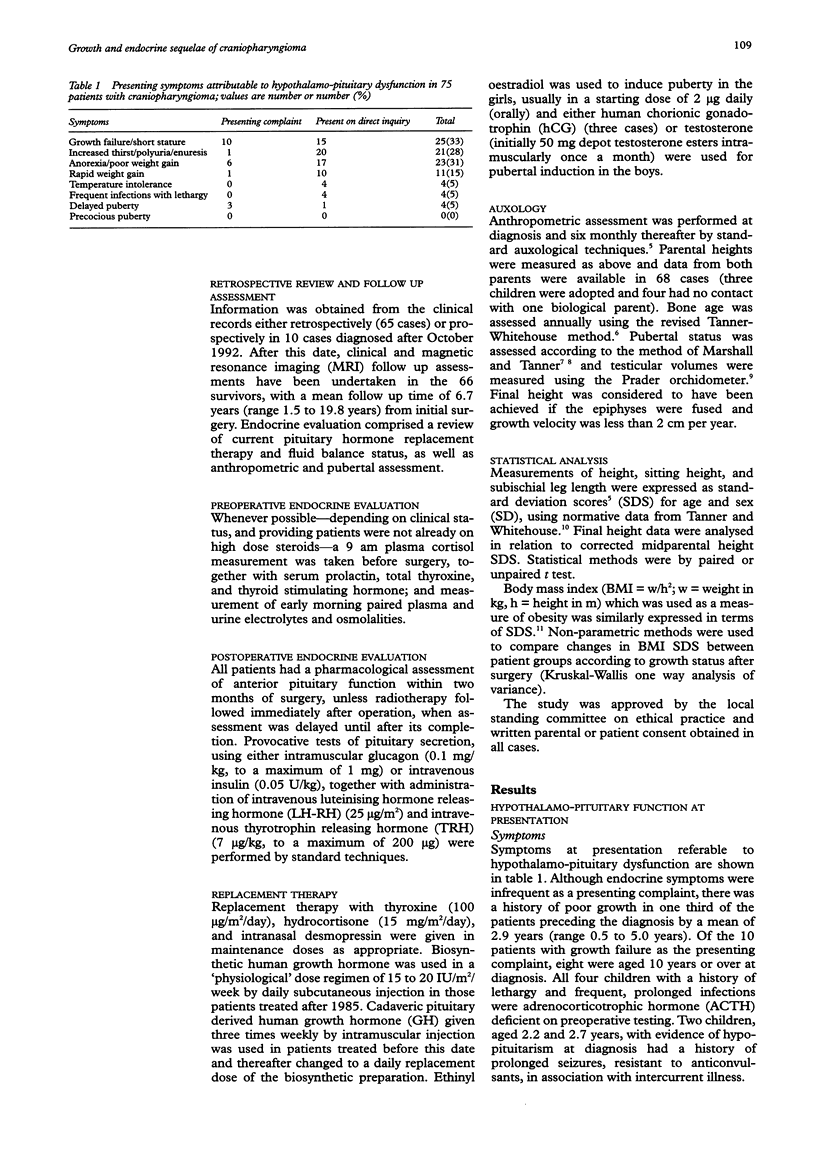
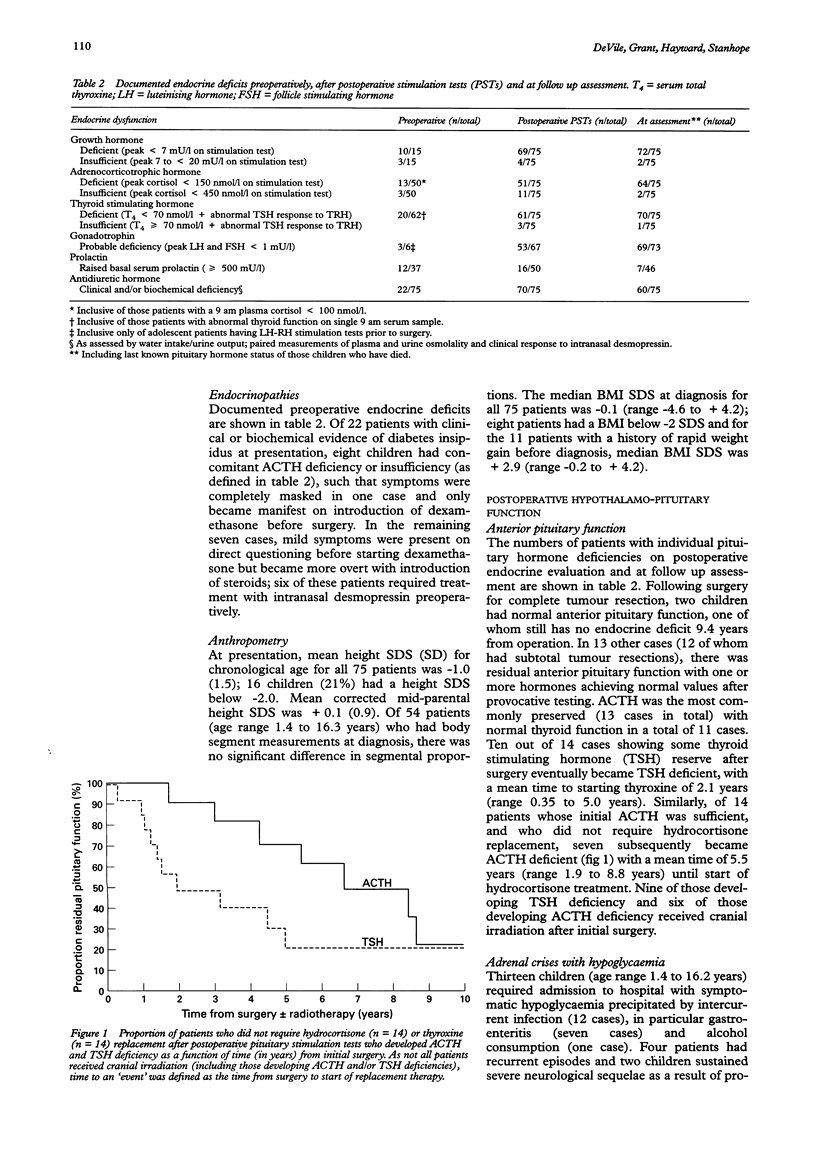
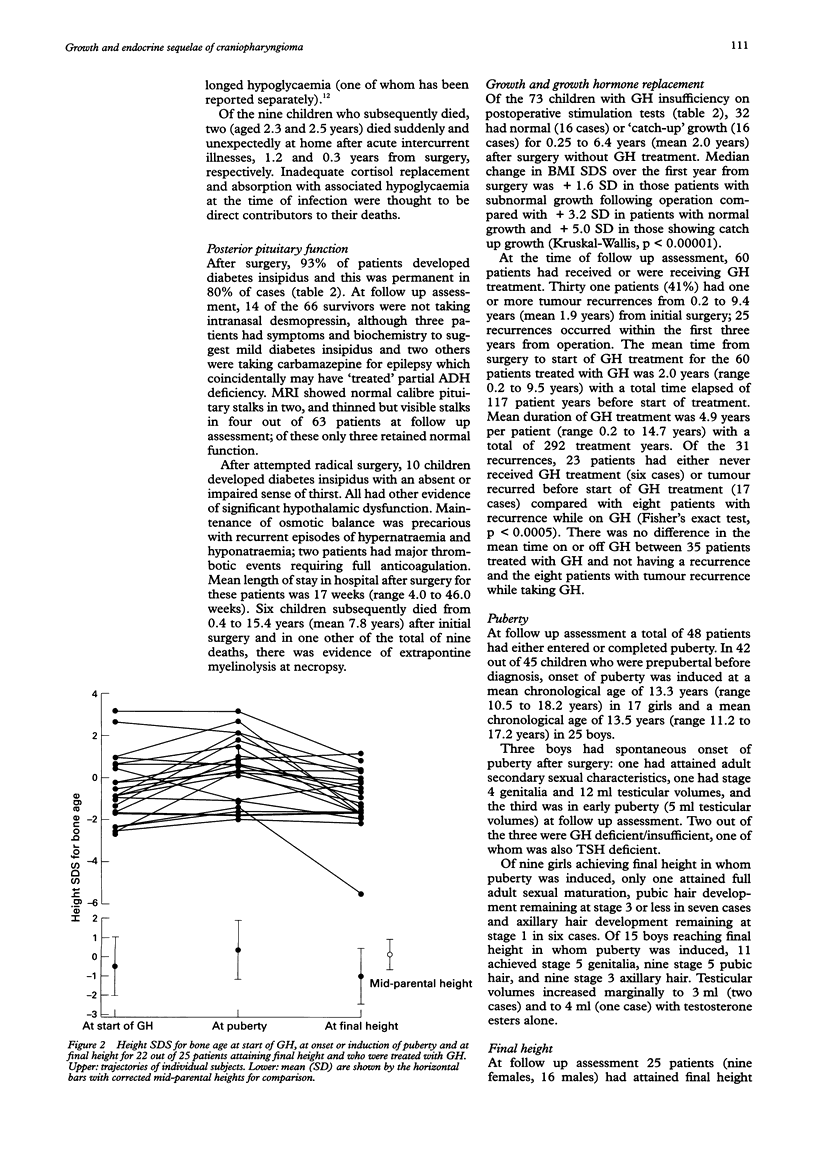
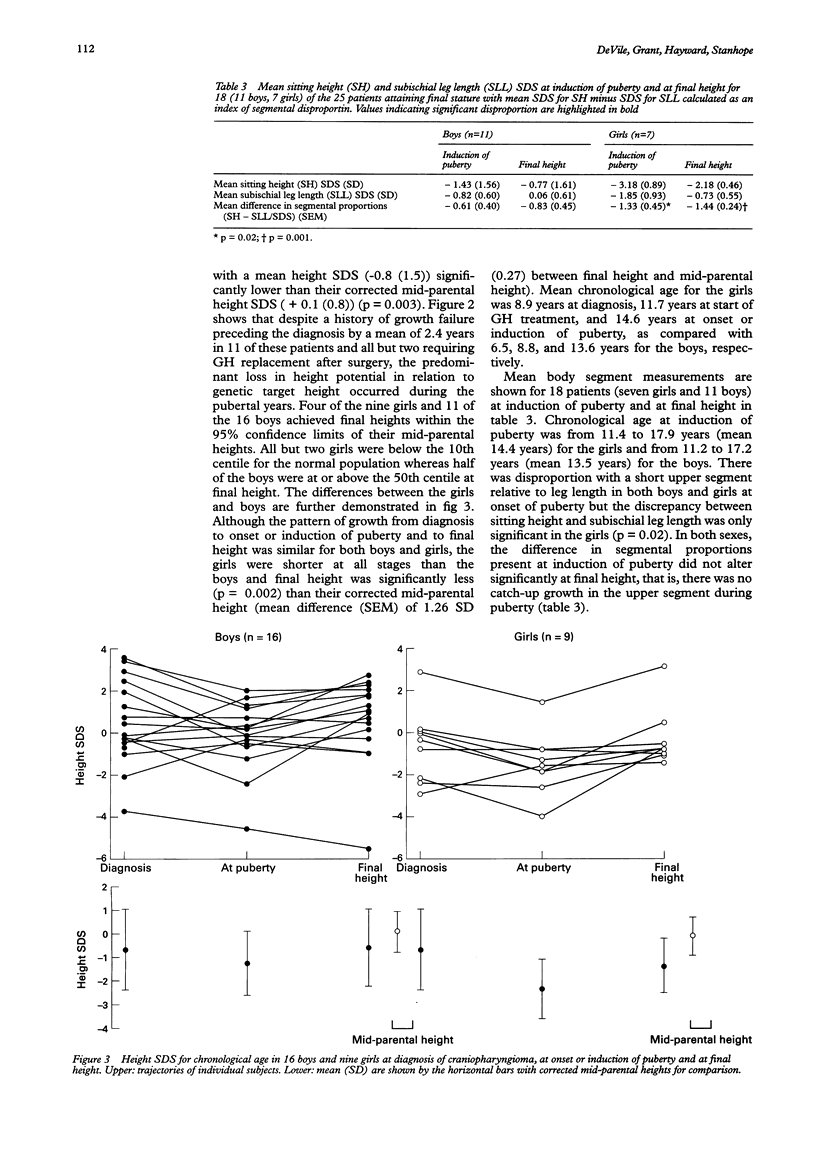
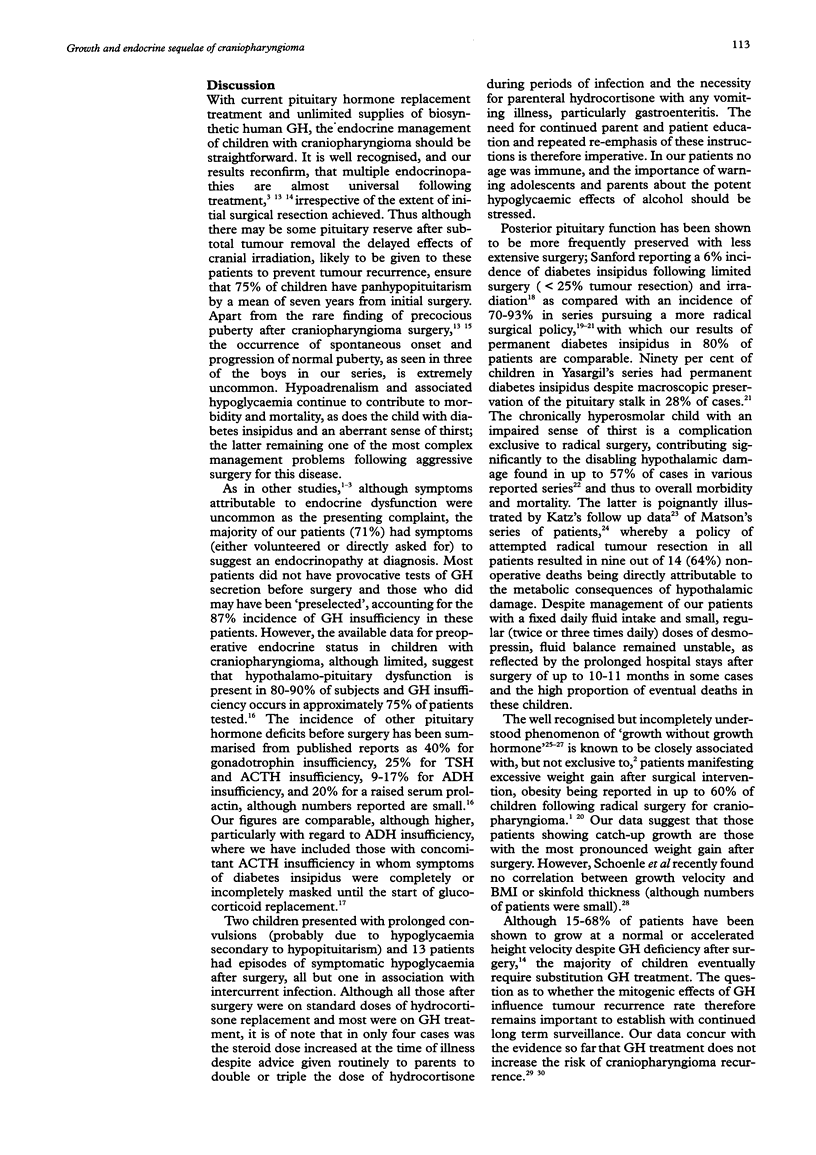
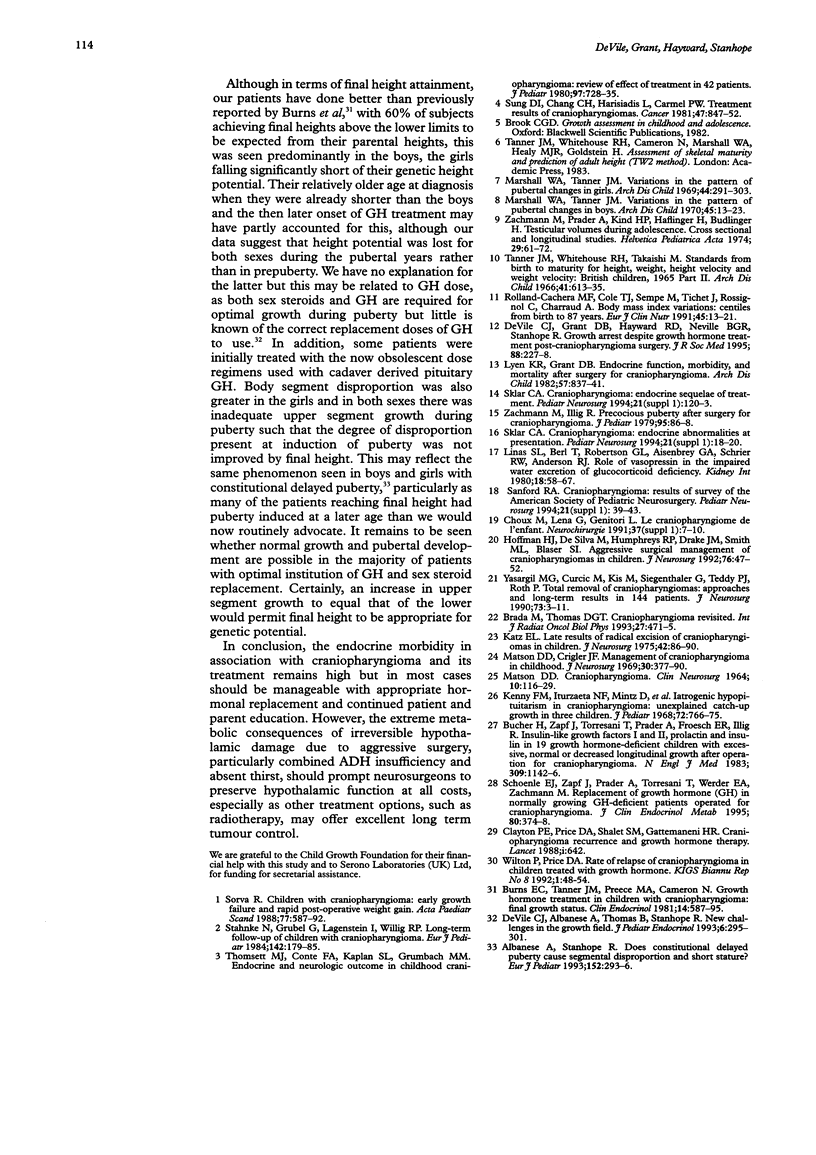
Selected References
These references are in PubMed. This may not be the complete list of references from this article.
- Albanese A., Stanhope R. Does constitutional delayed puberty cause segmental disproportion and short stature? Eur J Pediatr. 1993 Apr;152(4):293–296. doi: 10.1007/BF01956736. [DOI] [PubMed] [Google Scholar]
- Brada M., Thomas D. G. Craniopharyngioma revisited. Int J Radiat Oncol Biol Phys. 1993 Sep 30;27(2):471–475. doi: 10.1016/0360-3016(93)90261-s. [DOI] [PubMed] [Google Scholar]
- Bucher H., Zapf J., Torresani T., Prader A., Froesch E. R., Illig R. Insulin-like growth factors I and II, prolactin, and insulin in 19 growth hormone-deficient children with excessive, normal, or decreased longitudinal growth after operation for craniopharyngioma. N Engl J Med. 1983 Nov 10;309(19):1142–1146. doi: 10.1056/NEJM198311103091902. [DOI] [PubMed] [Google Scholar]
- Burns E. C., Tanner J. M., Preece M. A., Cameron N. Growth hormone treatment in children with craniopharyngioma: final growth status. Clin Endocrinol (Oxf) 1981 Jun;14(6):587–595. doi: 10.1111/j.1365-2265.1981.tb02969.x. [DOI] [PubMed] [Google Scholar]
- Clayton P. E., Price D. A., Shalet S. M., Gattemaneni H. R. Craniopharyngioma recurrence and growth hormone therapy. Lancet. 1988 Mar 19;1(8586):642–642. doi: 10.1016/s0140-6736(88)91434-1. [DOI] [PubMed] [Google Scholar]
- DeVile C. J., Albanese A., Thomas B., Stanhope R. New challenges in the growth field. J Pediatr Endocrinol. 1993 Jul-Dec;6(3-4):295–301. doi: 10.1515/jpem.1993.6.3-4.295. [DOI] [PubMed] [Google Scholar]
- Hoffman H. J., De Silva M., Humphreys R. P., Drake J. M., Smith M. L., Blaser S. I. Aggressive surgical management of craniopharyngiomas in children. J Neurosurg. 1992 Jan;76(1):47–52. doi: 10.3171/jns.1992.76.1.0047. [DOI] [PubMed] [Google Scholar]
- Katz E. L. Late results of radical excision of craniopharyngiomas in children. J Neurosurg. 1975 Jan;42(1):86–93. doi: 10.3171/jns.1975.42.1.0086. [DOI] [PubMed] [Google Scholar]
- Kenny F. M., Iturzaeta N. F., Mintz D., Drash A., Garces L. Y., Susen A., Askari H. A. Iatrogenic hypopituitarism in craniopharyngioma: unexplained catch-up growth in three children. J Pediatr. 1968 Jun;72(6):766–775. doi: 10.1016/s0022-3476(68)80428-7. [DOI] [PubMed] [Google Scholar]
- Linas S. L., Berl T., Robertson G. L., Aisenbrey G. A., Schrier R. W., Anderson R. J. Role of vasopressin in the impaired water excretion of glucocorticoid deficiency. Kidney Int. 1980 Jul;18(1):58–67. doi: 10.1038/ki.1980.110. [DOI] [PubMed] [Google Scholar]
- Lyen K. R., Grant D. B. Endocrine function, morbidity, and mortality after surgery for craniopharyngioma. Arch Dis Child. 1982 Nov;57(11):837–841. doi: 10.1136/adc.57.11.837. [DOI] [PMC free article] [PubMed] [Google Scholar]
- MATSON D. D. CRANIOPHARYNGIOMA. Clin Neurosurg. 1964;10:116–129. doi: 10.1093/neurosurgery/10.cn_suppl_1.116. [DOI] [PubMed] [Google Scholar]
- Marshall W. A., Tanner J. M. Variations in pattern of pubertal changes in girls. Arch Dis Child. 1969 Jun;44(235):291–303. doi: 10.1136/adc.44.235.291. [DOI] [PMC free article] [PubMed] [Google Scholar]
- Marshall W. A., Tanner J. M. Variations in the pattern of pubertal changes in boys. Arch Dis Child. 1970 Feb;45(239):13–23. doi: 10.1136/adc.45.239.13. [DOI] [PMC free article] [PubMed] [Google Scholar]
- Matson D. D., Crigler J. F., Jr Management of craniopharyngioma in childhood. J Neurosurg. 1969 Apr;30(4):377–390. doi: 10.3171/jns.1969.30.4.0377. [DOI] [PubMed] [Google Scholar]
- Rolland-Cachera M. F., Cole T. J., Sempé M., Tichet J., Rossignol C., Charraud A. Body Mass Index variations: centiles from birth to 87 years. Eur J Clin Nutr. 1991 Jan;45(1):13–21. [PubMed] [Google Scholar]
- Sanford R. A. Craniopharyngioma: results of survey of the American Society of Pediatric Neurosurgery. Pediatr Neurosurg. 1994;21 (Suppl 1):39–43. doi: 10.1159/000120860. [DOI] [PubMed] [Google Scholar]
- Schoenle E. J., Zapf J., Prader A., Torresani T., Werder E. A., Zachmann M. Replacement of growth hormone (GH) in normally growing GH-deficient patients operated for craniopharyngioma. J Clin Endocrinol Metab. 1995 Feb;80(2):374–378. doi: 10.1210/jcem.80.2.7852493. [DOI] [PubMed] [Google Scholar]
- Sklar C. A. Craniopharyngioma: endocrine abnormalities at presentation. Pediatr Neurosurg. 1994;21 (Suppl 1):18–20. doi: 10.1159/000120856. [DOI] [PubMed] [Google Scholar]
- Sklar C. A. Craniopharyngioma: endocrine sequelae of treatment. Pediatr Neurosurg. 1994;21 (Suppl 1):120–123. doi: 10.1159/000120873. [DOI] [PubMed] [Google Scholar]
- Sorva R. Children with craniopharyngioma. Early growth failure and rapid postoperative weight gain. Acta Paediatr Scand. 1988 Jul;77(4):587–592. doi: 10.1111/j.1651-2227.1988.tb10705.x. [DOI] [PubMed] [Google Scholar]
- Stahnke N., Grubel G., Lagenstein I., Willig R. P. Long-term follow-up of children with craniopharyngioma. Eur J Pediatr. 1984 Aug;142(3):179–185. doi: 10.1007/BF00442445. [DOI] [PubMed] [Google Scholar]
- Tanner J. M., Whitehouse R. H., Takaishi M. Standards from birth to maturity for height, weight, height velocity, and weight velocity: British children, 1965. II. Arch Dis Child. 1966 Dec;41(220):613–635. doi: 10.1136/adc.41.220.613. [DOI] [PMC free article] [PubMed] [Google Scholar]
- Thomsett M. J., Conte F. A., Kaplan S. L., Grumbach M. M. Endocrine and neurologic outcome in childhood craniopharyngioma: Review of effect of treatment in 42 patients. J Pediatr. 1980 Nov;97(5):728–735. doi: 10.1016/s0022-3476(80)80254-x. [DOI] [PubMed] [Google Scholar]
- Yaşargil M. G., Curcic M., Kis M., Siegenthaler G., Teddy P. J., Roth P. Total removal of craniopharyngiomas. Approaches and long-term results in 144 patients. J Neurosurg. 1990 Jul;73(1):3–11. doi: 10.3171/jns.1990.73.1.0003. [DOI] [PubMed] [Google Scholar]
- Zachmann M., Illig R. Precocious puberty after surgery for craniopharyngioma. J Pediatr. 1979 Jul;95(1):86–88. doi: 10.1016/s0022-3476(79)80095-5. [DOI] [PubMed] [Google Scholar]
- Zachmann M., Prader A., Kind H. P., Häfliger H., Budliger H. Testicular volume during adolescence. Cross-sectional and longitudinal studies. Helv Paediatr Acta. 1974 Apr;29(1):61–72. [PubMed] [Google Scholar]


